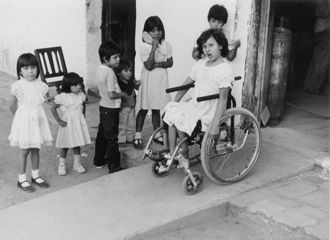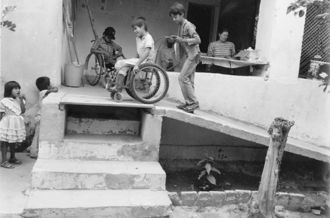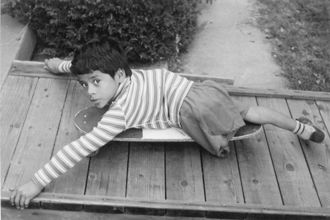Hesperian Health Guides
Adapting the Community
HealthWiki > Disabled Village Children > Chapter 51: Adapting the Home and Community > Adapting the Community
In many villages, people with disabilities have a hard time going places because streets or paths are rough, rocky, or sandy. Also, there may be high steps for getting into stores, the cinema, and even the town meeting hall, school, and health center.
A village rehabilitation program can encourage the villagers to make it easier for people with disabilities to go places and to participate in community activities.
For example, ask storekeepers to build ramps so that wheelchairs can enter their stores. People with disabilities and their families can promise to give their business to those who cooperate in this way, and if necessary, can boycott (refuse to buy from) those who do not.
 |
In Ajoya, Mexico, the rehabilitation team convinced store owners to build ramps so that the wheelchair riders could enter the stores. The store owners provided the materials and local masons volunteered the labor. |
| RAMPS | HOW STEEP YOU MAKE THE RAMP DEPENDS IN PART ON WHO IT IS FOR |
 The more gentle the slope of the ramp, the easier it is for a wheelchair rider to go up it. |
 Very steep slope
of 1 to 6 1
1 2 3 4 5 6 |
| Only possible with electric wheelchair or with help. Rarely possible for rider alone. Chair may tip backwards. | |

level platform
raised edge for safety
level platform |
 Fairly steep slope
of 1 to 10 1 2 3 4 5 6 7 8 9 10
1
Possible for riders with strong arms; strong people with paraplegia |
|
One or more ramps can be put parallel to the edge of the raised area. Be sure to leave large level platforms for turning.
|

Gentle grade slope of 1 to 14
1 2 3 4 5 6 7 8 9 10 11 12 13 14
1
Possible for average riders and strong people with quadriplegia. This is the best slope for public buildings and rehabilitation centers. |
Improvement of walkways and trails

Community work parties or groups of schoolchildren can organize to help fix up smooth, hard-packed pathways through the village so that crutch users and wheelchair riders can go places more easily.
Also, if possible, easy-to-use pathways can be set up so that children with disabilities and adults can get to play areas, bathing areas, and family work areas.
HAND RAILS (or ropes)
When placed along steep trails, these may permit children with vision loss, who have difficulty with balance, or who have difficulty walking to reach areas such as swimming or fishing holes.
In one village, a rehabilitation team together with some of the village children improved the steep trail down to the river, so that children with disabilities would have a chance to play and swim.
 |
 |
| The health workers of Project Piaxtla built this ramp so the wheelchair riders could come into the clinic more easily. (Photo: John Fago) | A narrow wood ramp with sideboards lets this child pull himself up it on his skateboard. |


